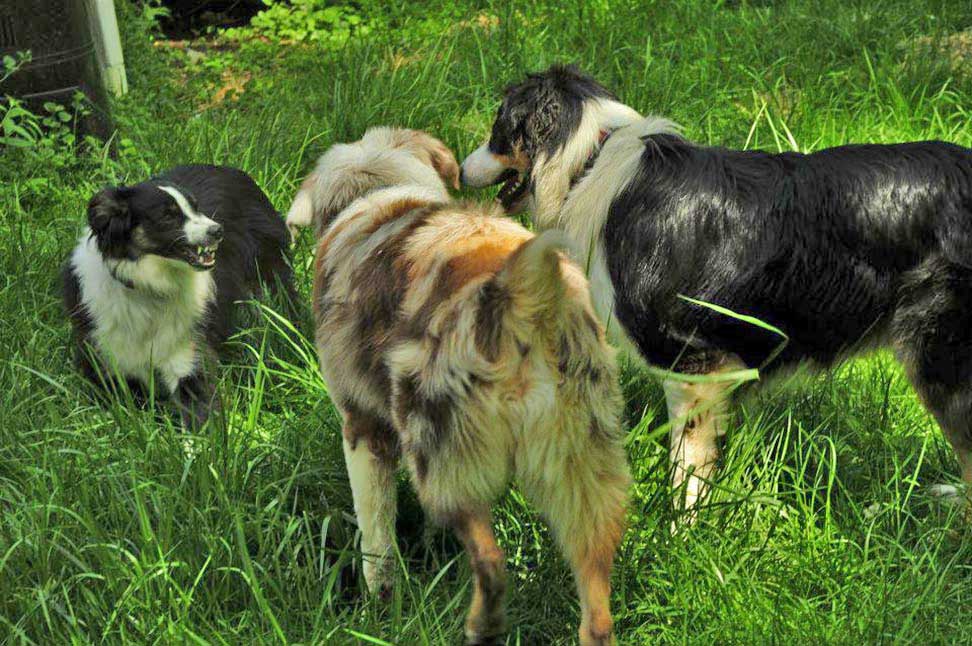Executive Decisions: Why Do You Have to Parent Your Crew?
Frequently, I walk into multiple dog households that are running amok, for lack of a better term. Some just a little, some far more than a little. In many cases, my presence would have been mostly unnecessary if someone had stepped in as the decision maker right off the bat. Simply put, stepping in as needed assures the safety of all your dogs.
Many of you, who are also human parents, understand the need for creating and enforcing boundaries. Fairness and polite behavior towards siblings is important for human harmony in a family. The same thing applies to the canine members as well.
This is not an advisory to micromanage your dogs’ interactions. A comment to this effect on the How Many Dogs Facebook page brought up this important point. Intervening is a judgment call in some cases. For what can be considered small things, no intervention is necessary if your dogs generally get along well. An example of this is a dog objecting to being stepped on by another dog, by grumbling or barking but nothing further. As long as the clumsy one is not inclined to redirect, that is a perfectly normal interaction between family members.
 Humans object to being jostled too, usually by reminding the jostler to be more careful. Dogs get this same privilege provided they can be reasonably polite about it. The key point here is to know your crew. If there are issues, you need to intervene far more often in order to prevent bigger problems.
Humans object to being jostled too, usually by reminding the jostler to be more careful. Dogs get this same privilege provided they can be reasonably polite about it. The key point here is to know your crew. If there are issues, you need to intervene far more often in order to prevent bigger problems.
Do not let your dogs work it out on their own! Not most of the time anyway. Really, the implications of such a scenario boggle the minds of behavior experts. It’s a recipe for disaster, just as allowing one’s human children to make inappropriate decisions regarding their interactions with their siblings. Oh sure, if you “raise them right”, some decisions will be appropriate. But so many more won’t be without initial supervision, intervention and consistency.
Consistency is the key word here. Set an example, make it happen all the time with few deviations, and you have a guideline for success. It doesn’t mean that you need to run your household like a boot camp. Nor does it mean that force needs used to ensure compliance. The best human parents don’t scream, shout and/or hit to handle their children’s infractions. They use conversations that include wise words and non scary but effective consequences for poor choices. But intervene they do, and because of that, the entire family feels a sense of security that all members are properly cared for emotionally and physically.
Will you always have to intervene? That depends on your particular crew and their relationships, but the goal is that you have to intervene as little as possible eventually – aside from preventing furniture from flying due to playtime bursts in the wrong rooms!
Security is one of the most important issues to any life form. Feeling secure allows everyone to relax. Safety from emotional and physical assaults ensures security. Give your crew security early on and you create the right formula to prevent problems later on. Combine safety and security with teaching manners and impulse control and you will put a lot of behavior consultants out of business!
Feel free to use the spaces below to describe how you create safety within your crew.
Posted in: Projects
Leave a Comment (4) →





 Now those of you who have never had the opportunity or the right circumstances to see such an issue for yourself may wonder what this consists of. The manifestation can vary according to the dog. I have a former class student who’s neutered male screams and stands on his back feet when he gets the close by scent of an intact male. This happened once with a dog in class owned by a friend, who I knew had just been neutered so we assumed that the surgery was simply too fresh. I later learned that said dog had a cryptorchid testicle so the hormones had not fully been removed. The reacting dog had been right!
Now those of you who have never had the opportunity or the right circumstances to see such an issue for yourself may wonder what this consists of. The manifestation can vary according to the dog. I have a former class student who’s neutered male screams and stands on his back feet when he gets the close by scent of an intact male. This happened once with a dog in class owned by a friend, who I knew had just been neutered so we assumed that the surgery was simply too fresh. I later learned that said dog had a cryptorchid testicle so the hormones had not fully been removed. The reacting dog had been right!










